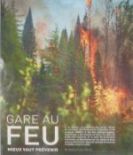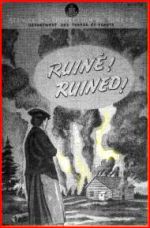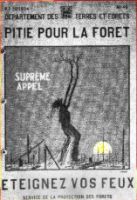Forest fires: main causes Historical conflagrations and prévention
The principal causes

Main causes of forest fires at that time:
. Fires lighted by settlers to clear their fields;
. camp fires that were not well extinguished and left unsupervised;
. sparks thrown off by train chimneys;
. natural causes like lightning or dry weather.
Conflagrations in Temiscaming
White Creek Fire : 1901, was a very disastrous year for forest fires in Temiscaming.
Fires were constantly spreading in different places which made detection difficult.
 That year the White Creek fire was the most disastrous. The heart of the fire was detected late, since
rain was keeping smoke low. Seven square miles (11,2km2) and around 8000 trees were destroyed.
That year the White Creek fire was the most disastrous. The heart of the fire was detected late, since
rain was keeping smoke low. Seven square miles (11,2km2) and around 8000 trees were destroyed.
1922 Great Fire: it began with a simple fire that started to burn within fallen trees and mixed
with dry weather and strong winds, progressed in a huge fire. On the Ontario side, it greatly affected the towns of Haileybury
and North Cobalt which were almost completely destroyed. On the Quebec side, the communities of Notre-Dame-du-Nord
and Notre-Dame-des-Quinze were affected the most. Furthermore, this fire was so devastating that it forced people
to jump into Temiscaming Lake to avoid being burnt. After the disaster, many people were left homeless; fortunately,
commitees were set up to provide these people with food, clothing and anything else.
Preventing Forest Fires
 To prevent forest fires, authorities used different mrthods such as laws about circulating in the forest and burning
of fallen wood. Also, superintendents would post information in regards to forest fire prevention.
In 1918 cinematograph technology was then used for fire prevention in a national tour of Exhibition Car
to inform people about forest conservation. This was very popular since people had little access to this
technology. Later, prevention was made through newspapers and then, through radio and television.
To prevent forest fires, authorities used different mrthods such as laws about circulating in the forest and burning
of fallen wood. Also, superintendents would post information in regards to forest fire prevention.
In 1918 cinematograph technology was then used for fire prevention in a national tour of Exhibition Car
to inform people about forest conservation. This was very popular since people had little access to this
technology. Later, prevention was made through newspapers and then, through radio and television.